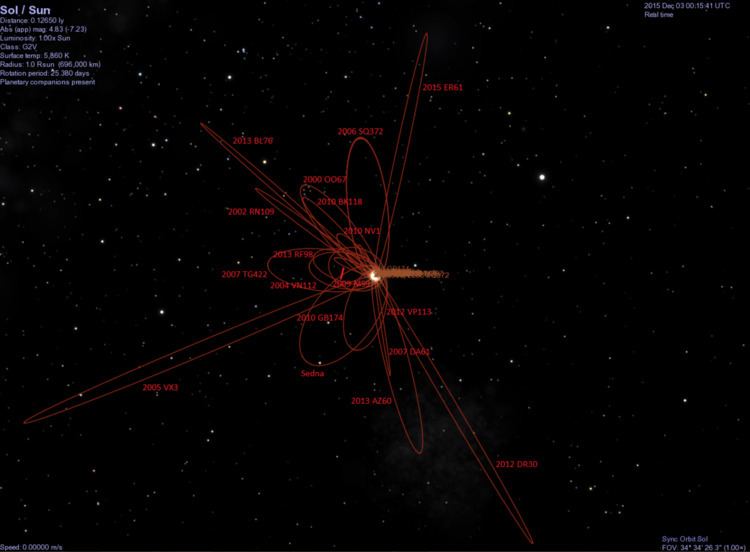Discovery date 27 September 2006 Observation arc 1830 days (5.01 yr) Discovered 27 September 2006 Argument of perihelion 122.34° Asteroid group Centaur | MPC designation 2006 SQ372 Orbital period 25,135 years Inclination 19.494° Discovery site Apache Point Observatory | |
 | ||
Discovered by A. C. Becker,A. W. Puckett,J. Kubica Minor planet category Scattered discCentaur (DES) Aphelion 1570 AU (Q)(Heliocentric 2006 AU) Similar Solar System, (148209) 2000 CR105, 2007 TG422 | ||
308933 2006 sq372
(308933) 2006 SQ372 is a small trans-Neptunian object discovered through the Sloan Digital Sky Survey by Andrew Becker, Andrew Puckett, and Jeremy Kubica on images first taken on September 27, 2006 (with precovery images dated to September 13, 2005).
Contents
It has a strongly eccentric orbit, crossing that of Neptune near perihelion but bringing it more than 1,500 AU from the Sun at aphelion. It takes about 22,500 years to orbit the barycenter of the Solar System. The large semi-major axis makes it similar to (87269) 2000 OO67 and 90377 Sedna. With an absolute magnitude (H) of 8.1, it is estimated to be about 60 to 140 km in diameter. Michael Brown estimates that it has an albedo of 0.08 which would give a diameter of around 110 km.
The object could possibly be a comet. The discoverers hypothesize that the object could come from the Hills cloud, but other scientists like California Institute of Technology's Michael Brown also consider other possibilities, as "it may have formed from debris just beyond Neptune [in the Kuiper belt] and been 'kicked' into its distant orbit by a planet like Neptune or Uranus".
Perturbation
More than half of the simulations of (308933) 2006 SQ372 show that it gets too close to either Uranus or Neptune within the next 180 million years, sending it in a currently unknown direction. This makes it difficult to classify this object as only a centaur or a scattered disc object. The Minor Planet Center (MPC), which officially catalogues all trans-Neptunian objects, lists centaurs and SDOs together. (29981) 1999 TD10 is another such object that blurs the two categories.
Given the extreme orbital eccentricity of this object, different epochs can generate quite different heliocentric unperturbed two-body best-fit solutions to the aphelion distance (maximum distance) of this object. With a 2005 epoch the object had an approximate period of about 22,000 years with aphelion at 1557 AU. But using a 2011 epoch shows a period of about 32,000 years with aphelion at 2006 AU. For objects at such high eccentricity, the Sun's barycentric coordinates are more stable than heliocentric coordinates. Using JPL Horizons with an observed orbital arc of only 2.9 years, the barycentric orbital elements for epoch 2008-May-14 generate a semi-major axis of 796 AU and a period of 22,466 years.
